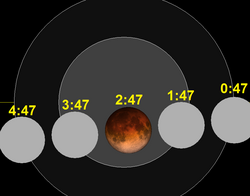| Total lunar eclipse September 28, 2015 | |
|---|---|
 From Murrieta, California, 2:52 UTC | |
Ecliptic north up The Moon passes right to left (west to east) through Earth's shadow | |
| Saros (and member) | 137 (28 of 81) |
| Gamma | −0.3296 |
| Magnitude | 1.2764 |
| Duration (hr:mn:sc) | |
| Totality | 1:11:55 |
| Partial | 3:19:52 |
| Penumbral | 5:10:41 |
| Contacts (UTC) | |
| P1 | 0:11:47 |
| U1 | 1:07:11 |
| U2 | 2:11:10 |
| Greatest | 2:47:08 |
| U3 | 3:23:05 |
| U4 | 4:27:03 |
| P4 | 5:22:27 |
 The Moon crosses Earth's shadow in Pisces, passing west to east (right to left) as shown here in hourly movements. Uranus, at magnitude 5.7, can be seen in binoculars 16 degrees east of the total eclipsed Moon. | |
A total lunar eclipse took place between 27 and 28 September 2015. It was seen on Sunday evening, 27 September, in the Americas; while in Europe, Africa, and the Middle East, it was seen in the early hours of Monday morning, 28 September. It was the latter of two total lunar eclipses in 2015, and the final in a tetrad (four total lunar eclipses in series). Other eclipses in the tetrad are those of 15 April 2014, 8 October 2014, and 4 April 2015.
The Moon appeared larger than normal, because the Moon was just 1 hour past its closest approach to Earth in 2015 at mid-eclipse, sometimes called a supermoon. The Moon's apparent diameter was larger than 34' viewed straight overhead, just off the coast of northeast Brazil.[1][2]
The total lunar eclipse was darker than expected, possibly due to ash left behind from eruptions of the Calbuco volcano in April 2015.[3]
- ^ Sky and Telescope
- ^ Here’s the Scoop on Sunday’s Supermoon Eclipse, Bob King
- ^ "Why Was September's Lunar Eclipse So Dark? - Universe Today". Universe Today. 5 October 2015. Retrieved 8 August 2017.